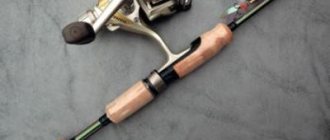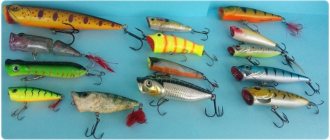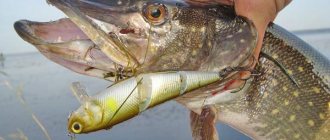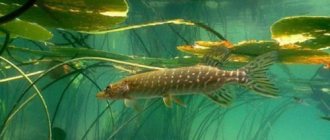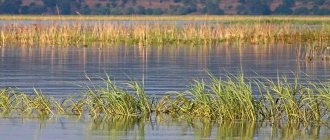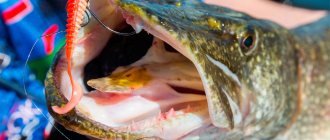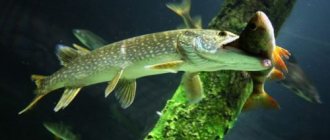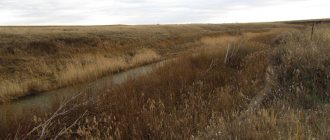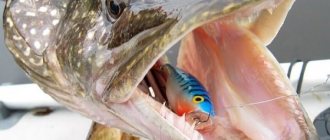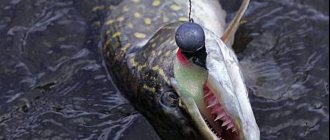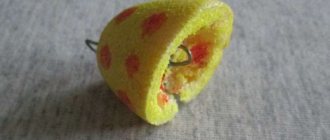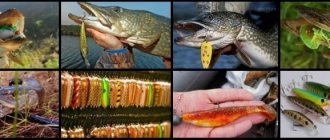Among the huge variety of lures for pike, poppers occupy a special place among spinners. Fishing for pike with a popper is not only effective, but also quite spectacular. During the fishing process, you can see how the pike quickly moves in the water column at the surface, cutting the water surface, and then violently attacks the bait. Splashes, desperate resistance, jumping out of the water... The spectacle is quite fascinating. We will talk about poppers and their features in this article.
What is a popper
A popper is a gurgling bait with a fish-shaped recess in the nose, which, when retrieved, teases predatory fish with splashes and squelches.
As a type of wobbler, the attachment is used for a spinning rod. Suitable for both pike and perch
Types of poppers and their features
There are two types of poppers:
- Floating . The entire body of the bait is on the surface of the water. They pass freely through obstacles (grass and algae), and are suitable for fishing in overgrown reservoirs.
- Drowning . Thanks to the sunken tail, the entire body of the bait, except for its small front part, is under water. When jerking upward it makes sharp squelching sounds. The long range of sinking poppers and the ability to “sink” perfectly attract predatory fish.
Both of them can be either one- or two-part.
To increase your catch, you can use sinking and floating poppers with attractant chambers and “rattles”.
Poppers and wobblers: what are the differences?
- The main difference between poppers and wobblers is in the shape of the nose: the former have a recess in the shape of a wide-open fish mouth, the latter in the form of a flat blade (see photo below);
- Wobblers can go deep to a considerable depth; the popper is designed for fishing exclusively in the surface layer;
- Another difference is the characteristic sound: when fishing, the holes in the front of the popper resemble the sounds made by small fish when feeding, which attracts predators.
Photo: Wobbler and popper (differences)
When and where are poppers used?
Lures are used in the warm season, when predatory fish are active, i.e. closer to dawn or in the evening. Floating poppers are ideal for surface fishing in shallow water, among weeds and snags. They catch small and medium pike well.
About
Types of poppers by design
The key design highlight is the recess in the bow. The nature of the created turbulence and the acoustic effect directly depend on it (that is, on the configuration, size). The shape of the cutout and the degree of sharpness of the edges determine the tonality of the sound. And, of course, the type of wiring also largely affects all of the listed manifestations. For example, with the “walking the dog” technique (known in professional slang as walk-the-dog, considered standard), with uniform winding, the nozzle will throw around differently - the nature of these throwing depends on the shape of the nose “bowl” of the popper.
How to choose a popper for pike
When choosing a popper for pike, you need to focus on the following points:
- Transparency and purity of water. The cleaner the water, the darker and more natural the bait should be. Bright and light-colored baits are suitable for fishing in troubled waters. The pike will become more willing to respond to them.
- Times of Day. It has been noticed that in the early morning the predator prefers red, black and orange poppers.
- Size. The catchiest poppers range from 5 to 13 centimeters.
- Center of gravity. It should be located towards the end, or in the middle.
Non-snagging frog poppers are suitable for very overgrown areas; fish poppers are suitable for open areas.
What to look for when choosing
When choosing a popper for pike, you must first of all pay attention to the size of the bait. The largest ones (up to 25 cm) catch trophy predators, the small ones catch smaller fish.
The front of the popper should be brightly colored. Thick poppers produce a richer gurgle than thin poppers. Balancing the bait and its resistance to the teeth of predators is also important.
Rating: 5 best poppers for pike
Based on quality, we can distinguish the top 5 best poppers for pike.
1. Megabass Pop Max
2. Strike Pro Giant Pop 160
3. Owner Cultiva Gobo Popper 60F
4. Daiwa TD Popper Zero
5. Fishycat Popcat 85F
- Megabass Pop Max . The rear is equipped with two weights, and the head has 6 holes, which enhances the gurgling. The steel ball inside creates additional vibration. Weight is 14 g, length - 8 cm. Available in assorted colors.
- Strike Pro Giant Pop 160 . The length of 16 cm and weight of 85.5 grams allow you to catch large predators, and the natural color and appearance increase the likelihood of a catch.
- Owner Cultiva Gobo Popper 60F . The small size and the slurping sound that occurs when retrieving attract small and medium-sized pike. Excellent for long casting. Weight is 6 g, length is 6 cm.
- Daiwa TD Popper Zero . It has indicators of 6.5 cm and 6 g. Natural appearance, low weight and the possibility of long casting provide a good catch.
- Fishycat Popcat 85F . It makes a sound reminiscent of playing a musical instrument, which, coupled with energetic wiring, enhances the hunting instincts of the pike. Parameters: 85 mm, 9.2 g.
About
What should a pike popper be like?
A good popper for pike fishing should be playful on the water, fast in the retrieve, and make a wave in front of itself. It should also be visible on the pond and release bubbles when cast. When controlling the bait, pay attention to the depth of its lowering and behavior when pulling in different directions.
After reading the article, you are convinced that pike poppers are an excellent bait for predators. You can also see the 10 best of them here. Happy fishing and big catch!
How to properly catch pike with a popper
Fishing for pike with a popper in the current and in calm water.
On the current
Wiring on the current is best done in the twitching style, i.e. repeating the technique of twitching the bait with the tip of the rod and winding the fishing line using a reel. Additional zigzag play enhances the effect.
You can fish with a uniform fast or slow retrieve: after casting the bait, you need to wait a couple of seconds, then reel in the line.
Fishing for pike with a popper in still water
Casting bait in still water should be done in predator ambush areas: under snags, among thickets, etc. The predator can be teased by making the bait gurgle in place and then smoothly move it forward. The main thing here is to make casts to the place where the pike is supposed to be found. If the catch is successful, you should change the place.
Concept and characteristics of poppers
A popper is an artificial bait, which is a type of wobbler.
In the name of the bait, the prefix “pop” means gurgling. Therefore, “popper” is the object that makes this gurgling sound.
Indeed, this type of bait, when immersed in water and during reeling, creates a kind of noise that attracts predatory fish species and provokes them to carry out an active attack.
Poppers differ from wobblers in the absence of a blade in the front part of the bait. There are also small recesses in these baits, with the help of which they make a peculiar gurgling sound. Poppers can also be equipped with additional chambers containing metal balls. Their movement through the cavity during wiring creates noise that attracts predators. Attractants can be added to another chamber, spreading tasty odors.
Poppers are used where all other baits cannot perform their functions correctly. The most suitable places include areas of the reservoir with a depth of up to 1-1.5 m, overgrown with reeds and other underwater vegetation. Thanks to their design and useful characteristics, poppers can overcome all difficult areas without a single snag, which is very important.
The effectiveness of these baits in the warm season cannot be disputed. The fact is that a lot of small fish feed near the surface of the water, frogs swim, waterfowl often land on the pond, and rodents fall from the shore, which leads them to inevitable death in the mouth of the pike, which hunts under the surface, leaving its victims not a single chance . When fishing, poppers for pike primarily lure them with an attractive squelch sound. Hoping to get easy prey, the fish attacks, but unexpectedly becomes a victim itself.
Poppers have a lot of advantages that provide many advantages to the fisherman when fishing. These include:
- Catchability. The pike confuses the bait with small fish feeding near the surface of the water and other potential victims, and at the sight of which it immediately attacks them.
Ease of use and safety. Due to the fact that poppers work on the surface, the risk of getting caught on an underwater obstacle is almost zero. In this case, it is necessary to skillfully fish out the pike so that it cannot swim away into the thickets and snags.- Casting distance. High-quality products, as a rule, have excellent balancing. Due to its characteristics and low weight, the bait can fly quite far.
- Opportunity to observe the behavior of bait and prey. This makes fishing more spectacular and convenient. While retrieving, you can see the moment the pike attacks, and when fishing, watch how it struggles, wriggles, trying to escape. The fisherman will be provided with an unforgettable experience.
- Sound. When the bait hits the water, it makes a peculiar sound, which the pike perceives as a signal to attack. It is similar to the one that accompanies rodents and frogs falling into water.
Despite the fact that poppers are considered to be surface baits, they are divided into two categories:
floating;- drowning.
Using floating poppers, difficult areas are fished. Sinking is more often used to find fish. When casting, the bait quickly sinks to the bottom of the reservoir, and when making sudden movements it instantly rises to the surface.
Popper fishing gear
Tackle is selected based on the following points:
- fishing line: strong, inextensible, providing the necessary sharpness when wiring;
- leash: long steel, not braided;
- rod: short, fast action, easy to handle;
- casting range: important in clear water, secondary in muddy water;
- bait: small - for small things, large - for large specimens.
A spinning rod with a bait of suitable weight allows for more accurate casting.
About
Features of seasonal pike fishing with popper
The season begins in late spring and continues until the first frost.
in spring
In the spring, when pike recover from the cold, a good place to fish is shallow water. The water there is warmer and there is more food for the predator.
In different latitudes of the country, fishing for pike begins after freeze-up, before spawning. At this time, the predator accumulates strength and hunts not at depth, but on the surface in shallow places.
In summer
Summer fishing includes features:
- Fishing for pike with a popper in mid-summer is carried out next to pike shelters. Shelters are located among algae, under snags, in the shade of trees, etc.
- An excellent time of day for fishing is morning and evening twilight, as well as cloudy weather.
- During rain and thunderstorms, the predator bites the bait more actively, especially away from shelter, but fishing in bad weather can be dangerous.
If fishing occurs in strong winds, it is worth taking stronger gear and spare baits with you.
